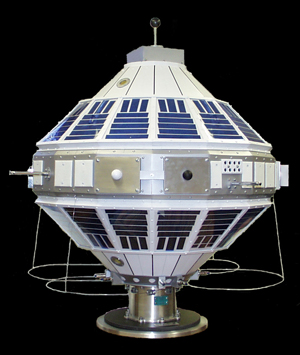
[ Archive ]

 |
ASPB and CIMSS Weekly Report
[ Archive ] |
 |
IN THE PRESS:
ITEMS FOR THE ADMINISTRATOR:
ITEMS FOR THE ASSISTANT ADMINISTRATOR:
50th Anniversary of Explorer-7 Celebrated: On
the evening of November 2, 2009, the University of Wisconsin
(UW)-Madison Space Science and Engineering Center (SSEC) celebrated,
with 300 guests, the successful launch of Explorer-7 (on October
13, 1959) and the subsequent successful operation of the first thermal
radiation balance experiment of the earth-atmosphere system. The
revolutionary instrument was designed by UW Professors Verner E. Suomi
and Robert Parent, and marked beginnings of an exciting 50 year period
of development of satellite remote sensing at SSEC, which was founded
by Suomi. In addition to a large display of photographs, artifacts,
documents, a full size Explorer-7 model, and other exhibits
(such as a 2-foot weather display globe), several excellent
entertaining and informative talks were presented by scientists who
knew Professor Suomi, such as G. Davis (NOAA/NESDIS Office of Systems
Development), Dr. J. M. Lewis (NOAA/OAR National Severe Storms
Laboratory), Dr. F. House (Drexel University), and Dr. T. Vonder Haar
(Colorado State University), among others. More information is
available at: http://www.ssec.wisc.edu/media/spotlight/explorer7.html. (P. Menzel, SSEC, 608-263-4930, paul.menzel@ssec.wisc.edu; J.
Phillips, SSEC, 608-262-8164, jean.phillips@ssec.wisc.edu; G. S. Wade,
E/RA2, 608-263-4743, gary.s.wade@noaa.gov)
 (Click image to enlarge)
(Click image to enlarge)
Figure
caption: This full-scale recreation of the Explorer-7 satellite was on
display at the 2009 UW-SSEC celebration of the 50th anniversary of the
satellite's successful launch and operation.
Significance: Suomi and Parent, professors from the University of Wisconsin-Madison, had conceived, designed, and built the innovative radiometer on the Explorer-7 satellite. Their instrument made it into orbit and operated properly, opening the world to satellite meteorology. It was the first successful satellite measure of the Earth’s climate.
NOAA Mission Goal: Serve society's needs for weather and water information; Provide critical support for NOAA's missionThe 6th GOES Users' Conference: The
6th Geostationary Operational Environmental Satellite (GOES) Users'
Conference was held in Madison, Wisconsin, November 3-5, 2009, at the Monona Terrace Convention Center. The
focus was the current, near-term, and future geostationary systems.
There were over 260 participants from government, private industry,
academia, and the international community, including representatives
from EUropean organization for the exploitation of METeorological
SATellites (EUMETSAT), the World Meteorological Organization (WMO),
China, Japan, Korea, India, Brazil, and Canada. The conference consisted
of oral presentations, poster sessions, panel discussions, and a town hall
meeting. The town hall meeting addressed the issue of high spectral
resolution sounding in a geostationary orbit. The breakout sessions
provided an opportunity for the user communities to give their input
on ensuring user readiness for the GOES-R series. More details about
the conference can be found at http://cimss.ssec.wisc.edu/goes_r/meetings/guc2009/. (T. Schmit, E/RA2, 608-263-0291, tim.j.schmit@noaa.gov; James Gurka, NOAA, 301-286-1364)
Significance: The GOES Users' Conferences provide a forum for the exchange of information and ideas between satellite operators, data producers, and data users. The conferences bring together government, academia, and private industry, both nationally and internationally, to discuss NOAA's current and future geostationary satellite systems.
ITEMS FOR THE OFFICE DIRECTOR, STAR:
Paper on Arctic Climate Interactions Published and Highlighted: A paper on the influence of changes in cloud cover and sea ice extent on trends in Arctic surface temperature was published in Geophysical Research Letters ("Influence of changes in sea ice concentration and cloud cover on recent Arctic surface temperature trends", 36, L20710, doi:10.1029/2009GL040708). The paper was selected as an AGU Journal Highlight. The authors are Yinghui Liu (Cooperative Institute for Meteorological Satellite Studies, CIMSS), Jeff Key (NESDIS/STAR), and Xuanji Wang (CIMSS). (Y. Liu, CIMSS; J. Key, E/RA2, 608-263-2605, jkey@ssec.wisc.edu)ITEMS FOR THE DIVISION CHIEF, CoRP:
Manuscript on Cloud Composition Submitted: A manuscript entitled “Advances in Extracting Cloud Composition Information from Spaceborne Infrared Radiances: A Robust Alternative to Brightness Temperatures. Part I: Theory” was submitted to the Journal of Applied Meteorology and Climatology. The author is M. Pavolonis. The paper describes the theory behind a new methodology for determining cloud phase and identifying volcanic ash and dust clouds. The methodology is applicable to broadband or hyperspectral infrared radiances. (M. Pavolonis, E/RA2, 608-263-9597, Mike.Pavolonis@noaa.gov)GOES User Conference Poster on GOES-R visibility retrieval: A poster entitled "Development of a visibility retrieval for the GOES-R Advanced Baseline Imager" was presented at the 6th Annual GOES User Conference in Madison, WI. The poster summarizes a comparison between GOES-R Advanced Baseline Imager (ABI) visibility retrievals, model based estimates from the NCEP North American Model (NAM), and Automated Surface Observing Systems (ASOS) visibility reports for July, 2008. The results of this analysis show that the GOES-R visibility retrieval provides useful information during periods of moderate clear-sky visibility. However, systematic biases in classification of Low and Moderate visibility events point to the need to perform seasonal and/or regionally dependent bias corrections to meet ABI design specifications of 80% correct classification.
(R.B. Pierce, E/RA2, 608-890-1892, brad.pierce@noaa.gov, A. Lenzen, SSEC, 608-263-3897, M. Pavolonis, E/RA2, 608-263-9597, mpav@ssec.wisc.edu,,A. Heidinger, E/RA2, 608-263-6757, andrew.heidinger@noaa.gov, S. Kondragunta, 301-763-8136 x 151)
NEXT WEEK:
LOOKING AHEAD:
| Archived Weeklies Page | Submit a report item |